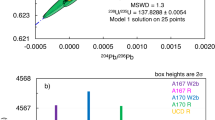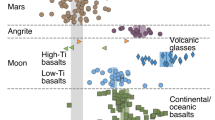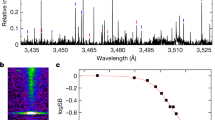Abstract
THE potassium of the iron meteorite ‘Carbo’, compared with ordinary potassium, is substantially enriched in the isotopes potassium-40 and -41, as shown in the recent isotopic analysis by Voshage and Hintenberger1. At least 15 per cent of these isotopes in their sample of ‘Carbo’ appear to have been produced through the action of cosmic rays. Stoenner and Zähringer2 found that the concentration of potassium may vary considerably within an iron meteorite. Their analyses were based on the detection of potassium-41 and the assumption that the potassium had the same isotopic composition as terrestrial potassium. If, however, their value of 0.031 p.p.m. of potassium from one sample is typical of ‘Carbo’ and is corrected to 0.012 p.p.m. in order to fit the new isotopic analysis, the potassium produced by spallation is at least 4.6 × 10−11 mole/gm. The total ion beam in the Voshage and Hintenberger analysis indicated that the concentration of potassium-40 alone is even greater than 1.8 × 10−12 mole/gm. The amount of potassium produced by spallation is probably about 10−11 mole/gm. This figure is quite compatible with that of 1.1 × 10−10 mole/gm. for the helium-3 content2 because the cross-section for the formation of potassium, including the contribution from argon-39 and calcium-41, seems to be3 about 40 mb., and the measured cross-section for the production of helium-3 (with hydrogen-3) by means of 3 BeV. protons on iron is approximately4 340 mb. The neon also formed by spallation has a concentration5 of 5.8 × 10−12 mole/gm., which is comparable with that indicated for the potassium.
This is a preview of subscription content, access via your institution
Access options
Subscribe to this journal
Receive 51 print issues and online access
$199.00 per year
only $3.90 per issue
Buy this article
- Purchase on Springer Link
- Instant access to full article PDF
Prices may be subject to local taxes which are calculated during checkout
Similar content being viewed by others
References
Voshage, H., and Hintenberger, H., Z. Naturf., 14,a, 194 (1959).
Stoenner, R. W., and Zähringer, J., Geochim. et Cosmochim. Acta, 15, 40 (1958).
Barr, D. W., thesis, University of California, Radiation Laboratory Report 3793 (1957).
Schaeffer, O. A., and Zähringer, H., Z. Naturf., 13,a, 346 (1958).
Wänke, H., and Hintenberger, H., Z. Naturf., 13,a, 895 (1958).
Geiss, J., Chimia, 11, 349 (1957).
Patterson, C. C., Geochim. et Cosmochim. Acta, 7, 151 (1955).
Marshall, R. R., and Hess, D. C., J. Chem. Phys., 28, 1258 (1958).
Schumacher, E., Z. Naturf., 11,a, 206 (1956).
Webster, R. K., Morgan, J. W., and Smales, A. A., Trans. Amer. Geophys. Union, 38, 543 (1957).
Reed, G. W., in Proc. Third Conf. on Nuclear Processes in Geologic Settings. Massachusetts Institute of Technology, 27 (National Academy of Sciences—National Research Council Pub. 572, 1957).
Gerling, E. K., and Levskii, L. K., Dokl. Akad. Nauk. SSSR, 110, No. 5, 750 (1956).
Geiss, J., and Hess, D. C., Astrophys. J., 127, 224 (1958).
Reed, G. W., and Turkevich, A., Nature, 180, 594 (1957).
Author information
Authors and Affiliations
Rights and permissions
About this article
Cite this article
MARSHALL, R. Calculation of a ‘Cosmic Ray Age’ for the Iron Meteorite ‘Carbo’. Nature 184, 117–118 (1959). https://doi.org/10.1038/184117b0
Issue Date:
DOI: https://doi.org/10.1038/184117b0
This article is cited by
Comments
By submitting a comment you agree to abide by our Terms and Community Guidelines. If you find something abusive or that does not comply with our terms or guidelines please flag it as inappropriate.



